FINANCE PORTFOLIO MANAGEMENT REPORT: India and Malaysia Analysis
VerifiedAdded on 2020/02/19
|15
|3296
|35
Report
AI Summary
This report provides a comprehensive analysis of finance portfolio management, focusing on investment opportunities in the emerging markets of India and Malaysia for Australian investors. It begins with an introduction and literature review outlining the economic and political scenarios of both countries, including GDP growth, interest rates, exchange rates, and employment. The analysis section identifies key industries, evaluates the performance of cash, fixed interest, and equities, and discusses the advantages and disadvantages of establishing a country fund. The report also offers recommendations for portfolio managers based on the identified market trends and economic indicators. The report highlights the potential of the Indian market, with its growth stage, and the stability of the Malaysian market, and provides insights into currency fluctuations and industry-specific investment strategies.

Running head: FINANCE PORTFOLIO MANAGEMENT
Finance Portfolio Management
Name of the Student:
Name of the University:
Author’s Note:
Finance Portfolio Management
Name of the Student:
Name of the University:
Author’s Note:
Paraphrase This Document
Need a fresh take? Get an instant paraphrase of this document with our AI Paraphraser
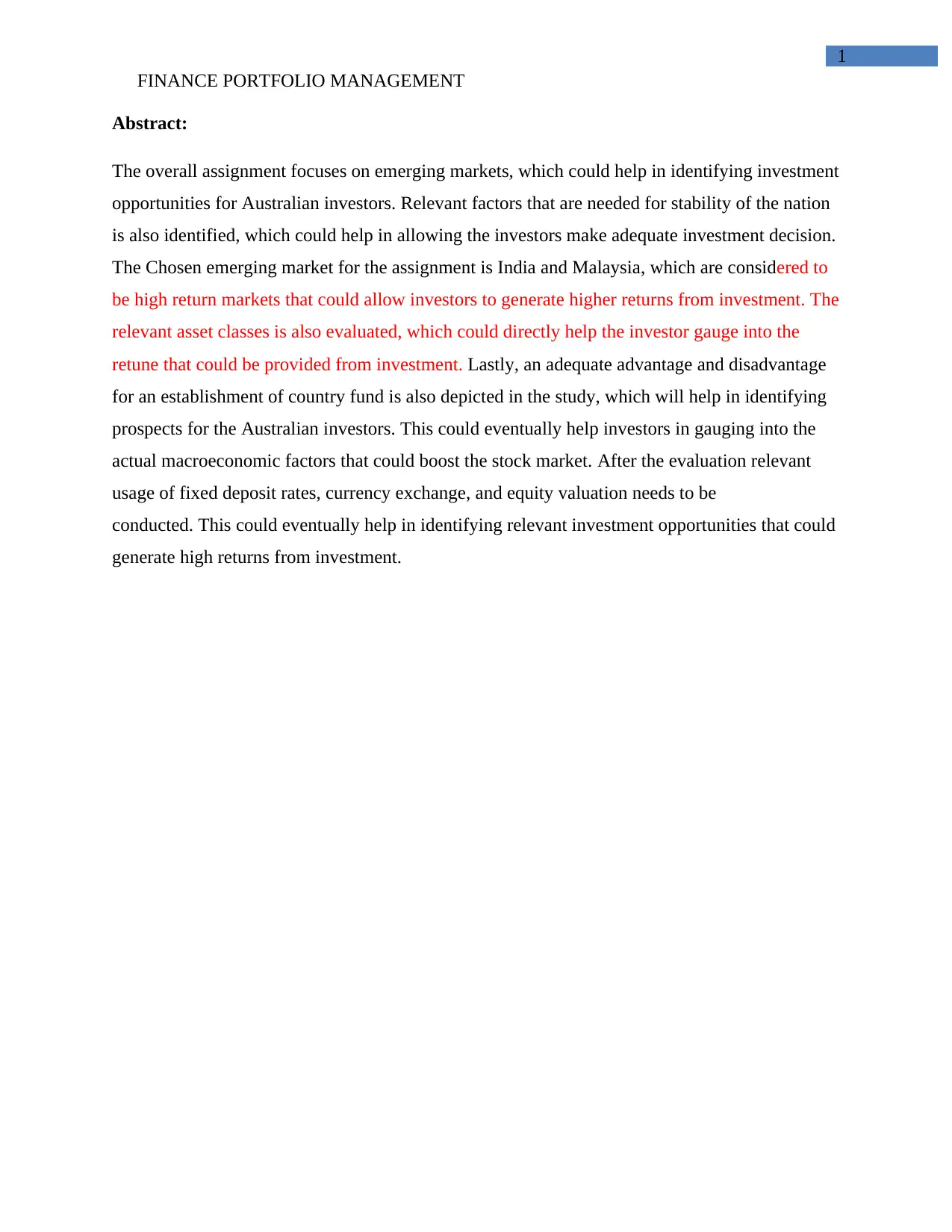
FINANCE PORTFOLIO MANAGEMENT
1
Abstract:
The overall assignment focuses on emerging markets, which could help in identifying investment
opportunities for Australian investors. Relevant factors that are needed for stability of the nation
is also identified, which could help in allowing the investors make adequate investment decision.
The Chosen emerging market for the assignment is India and Malaysia, which are considered to
be high return markets that could allow investors to generate higher returns from investment. The
relevant asset classes is also evaluated, which could directly help the investor gauge into the
retune that could be provided from investment. Lastly, an adequate advantage and disadvantage
for an establishment of country fund is also depicted in the study, which will help in identifying
prospects for the Australian investors. This could eventually help investors in gauging into the
actual macroeconomic factors that could boost the stock market. After the evaluation relevant
usage of fixed deposit rates, currency exchange, and equity valuation needs to be
conducted. This could eventually help in identifying relevant investment opportunities that could
generate high returns from investment.
1
Abstract:
The overall assignment focuses on emerging markets, which could help in identifying investment
opportunities for Australian investors. Relevant factors that are needed for stability of the nation
is also identified, which could help in allowing the investors make adequate investment decision.
The Chosen emerging market for the assignment is India and Malaysia, which are considered to
be high return markets that could allow investors to generate higher returns from investment. The
relevant asset classes is also evaluated, which could directly help the investor gauge into the
retune that could be provided from investment. Lastly, an adequate advantage and disadvantage
for an establishment of country fund is also depicted in the study, which will help in identifying
prospects for the Australian investors. This could eventually help investors in gauging into the
actual macroeconomic factors that could boost the stock market. After the evaluation relevant
usage of fixed deposit rates, currency exchange, and equity valuation needs to be
conducted. This could eventually help in identifying relevant investment opportunities that could
generate high returns from investment.
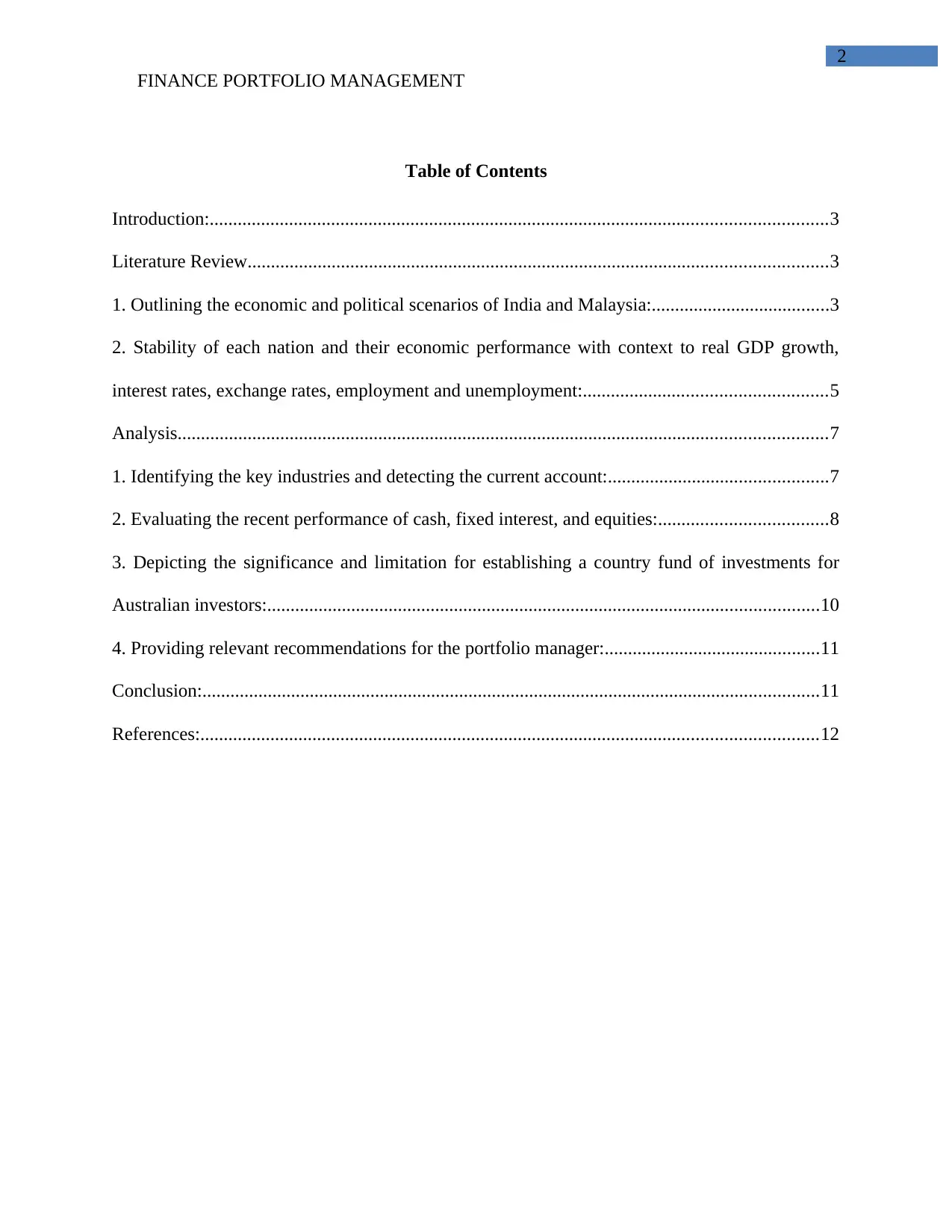
FINANCE PORTFOLIO MANAGEMENT
2
Table of Contents
Introduction:....................................................................................................................................3
Literature Review............................................................................................................................3
1. Outlining the economic and political scenarios of India and Malaysia:......................................3
2. Stability of each nation and their economic performance with context to real GDP growth,
interest rates, exchange rates, employment and unemployment:....................................................5
Analysis...........................................................................................................................................7
1. Identifying the key industries and detecting the current account:...............................................7
2. Evaluating the recent performance of cash, fixed interest, and equities:....................................8
3. Depicting the significance and limitation for establishing a country fund of investments for
Australian investors:......................................................................................................................10
4. Providing relevant recommendations for the portfolio manager:..............................................11
Conclusion:....................................................................................................................................11
References:....................................................................................................................................12
2
Table of Contents
Introduction:....................................................................................................................................3
Literature Review............................................................................................................................3
1. Outlining the economic and political scenarios of India and Malaysia:......................................3
2. Stability of each nation and their economic performance with context to real GDP growth,
interest rates, exchange rates, employment and unemployment:....................................................5
Analysis...........................................................................................................................................7
1. Identifying the key industries and detecting the current account:...............................................7
2. Evaluating the recent performance of cash, fixed interest, and equities:....................................8
3. Depicting the significance and limitation for establishing a country fund of investments for
Australian investors:......................................................................................................................10
4. Providing relevant recommendations for the portfolio manager:..............................................11
Conclusion:....................................................................................................................................11
References:....................................................................................................................................12
⊘ This is a preview!⊘
Do you want full access?
Subscribe today to unlock all pages.

Trusted by 1+ million students worldwide
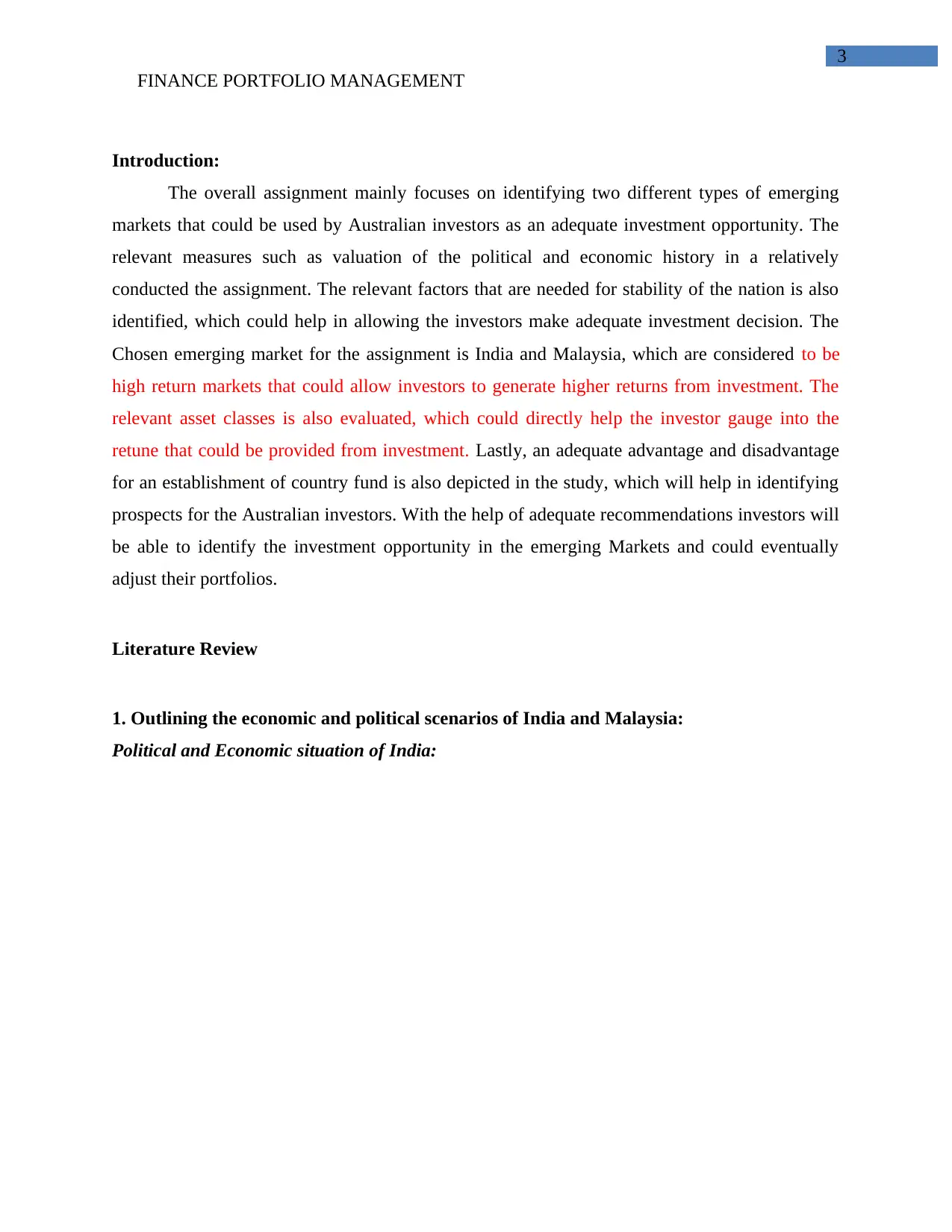
FINANCE PORTFOLIO MANAGEMENT
3
Introduction:
The overall assignment mainly focuses on identifying two different types of emerging
markets that could be used by Australian investors as an adequate investment opportunity. The
relevant measures such as valuation of the political and economic history in a relatively
conducted the assignment. The relevant factors that are needed for stability of the nation is also
identified, which could help in allowing the investors make adequate investment decision. The
Chosen emerging market for the assignment is India and Malaysia, which are considered to be
high return markets that could allow investors to generate higher returns from investment. The
relevant asset classes is also evaluated, which could directly help the investor gauge into the
retune that could be provided from investment. Lastly, an adequate advantage and disadvantage
for an establishment of country fund is also depicted in the study, which will help in identifying
prospects for the Australian investors. With the help of adequate recommendations investors will
be able to identify the investment opportunity in the emerging Markets and could eventually
adjust their portfolios.
Literature Review
1. Outlining the economic and political scenarios of India and Malaysia:
Political and Economic situation of India:
3
Introduction:
The overall assignment mainly focuses on identifying two different types of emerging
markets that could be used by Australian investors as an adequate investment opportunity. The
relevant measures such as valuation of the political and economic history in a relatively
conducted the assignment. The relevant factors that are needed for stability of the nation is also
identified, which could help in allowing the investors make adequate investment decision. The
Chosen emerging market for the assignment is India and Malaysia, which are considered to be
high return markets that could allow investors to generate higher returns from investment. The
relevant asset classes is also evaluated, which could directly help the investor gauge into the
retune that could be provided from investment. Lastly, an adequate advantage and disadvantage
for an establishment of country fund is also depicted in the study, which will help in identifying
prospects for the Australian investors. With the help of adequate recommendations investors will
be able to identify the investment opportunity in the emerging Markets and could eventually
adjust their portfolios.
Literature Review
1. Outlining the economic and political scenarios of India and Malaysia:
Political and Economic situation of India:
Paraphrase This Document
Need a fresh take? Get an instant paraphrase of this document with our AI Paraphraser
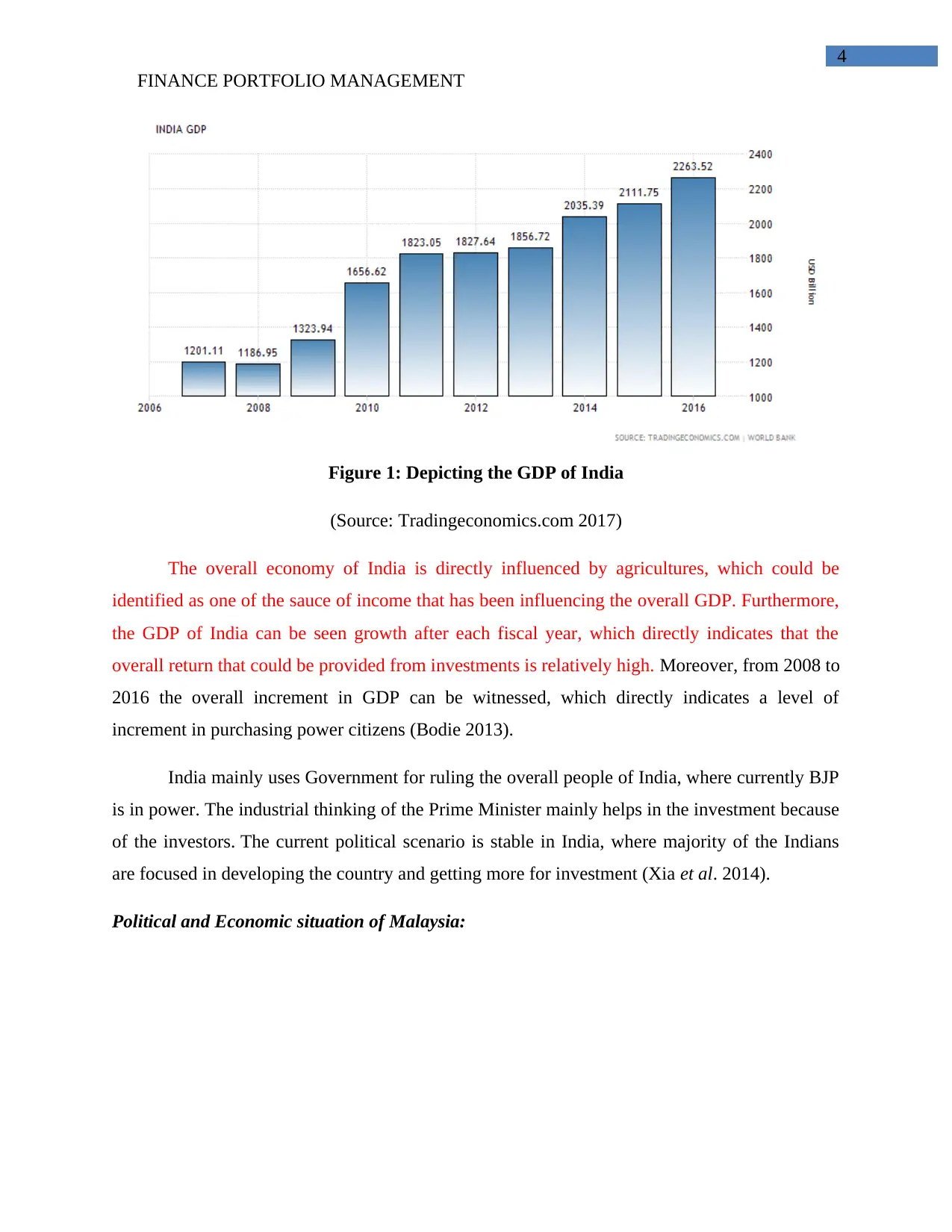
FINANCE PORTFOLIO MANAGEMENT
4
Figure 1: Depicting the GDP of India
(Source: Tradingeconomics.com 2017)
The overall economy of India is directly influenced by agricultures, which could be
identified as one of the sauce of income that has been influencing the overall GDP. Furthermore,
the GDP of India can be seen growth after each fiscal year, which directly indicates that the
overall return that could be provided from investments is relatively high. Moreover, from 2008 to
2016 the overall increment in GDP can be witnessed, which directly indicates a level of
increment in purchasing power citizens (Bodie 2013).
India mainly uses Government for ruling the overall people of India, where currently BJP
is in power. The industrial thinking of the Prime Minister mainly helps in the investment because
of the investors. The current political scenario is stable in India, where majority of the Indians
are focused in developing the country and getting more for investment (Xia et al. 2014).
Political and Economic situation of Malaysia:
4
Figure 1: Depicting the GDP of India
(Source: Tradingeconomics.com 2017)
The overall economy of India is directly influenced by agricultures, which could be
identified as one of the sauce of income that has been influencing the overall GDP. Furthermore,
the GDP of India can be seen growth after each fiscal year, which directly indicates that the
overall return that could be provided from investments is relatively high. Moreover, from 2008 to
2016 the overall increment in GDP can be witnessed, which directly indicates a level of
increment in purchasing power citizens (Bodie 2013).
India mainly uses Government for ruling the overall people of India, where currently BJP
is in power. The industrial thinking of the Prime Minister mainly helps in the investment because
of the investors. The current political scenario is stable in India, where majority of the Indians
are focused in developing the country and getting more for investment (Xia et al. 2014).
Political and Economic situation of Malaysia:
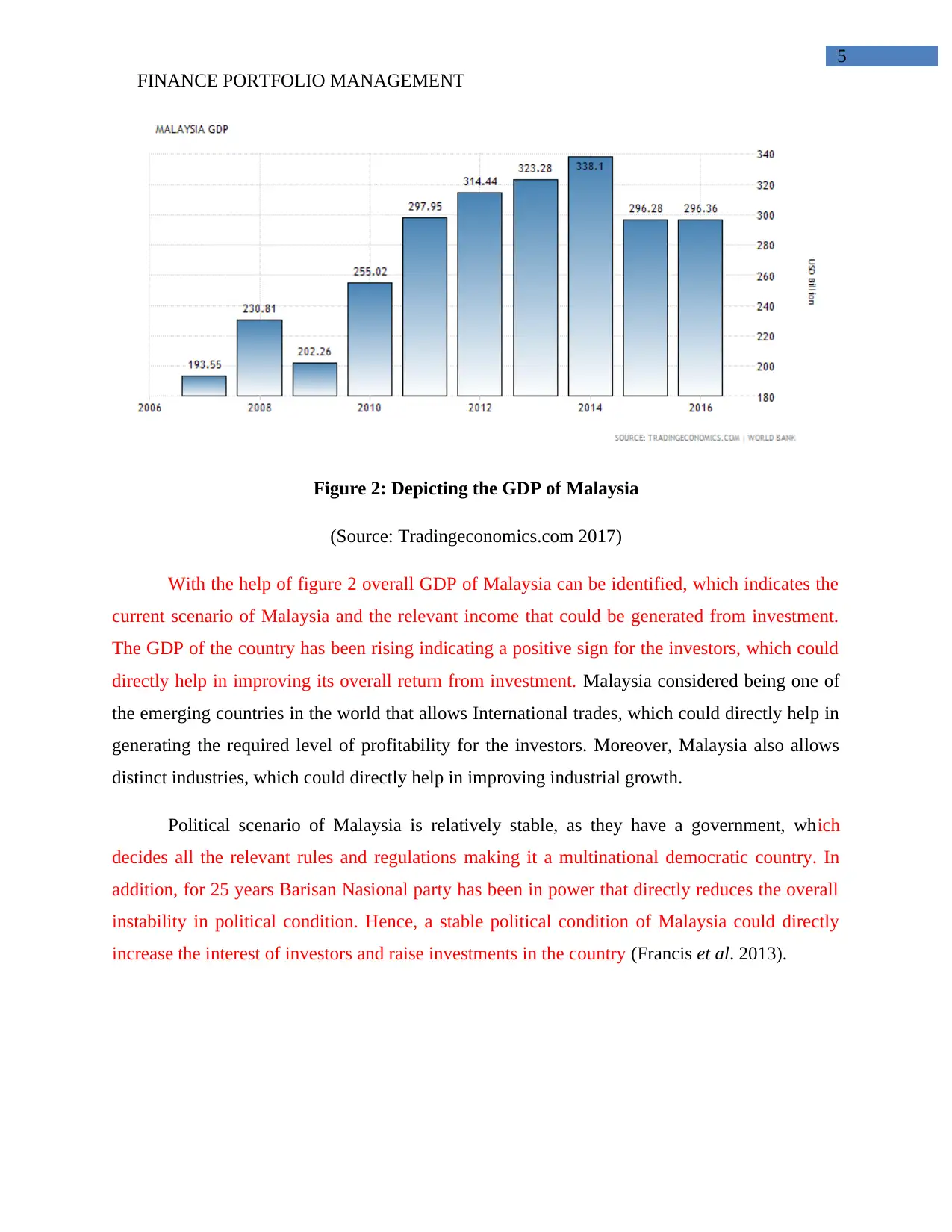
FINANCE PORTFOLIO MANAGEMENT
5
Figure 2: Depicting the GDP of Malaysia
(Source: Tradingeconomics.com 2017)
With the help of figure 2 overall GDP of Malaysia can be identified, which indicates the
current scenario of Malaysia and the relevant income that could be generated from investment.
The GDP of the country has been rising indicating a positive sign for the investors, which could
directly help in improving its overall return from investment. Malaysia considered being one of
the emerging countries in the world that allows International trades, which could directly help in
generating the required level of profitability for the investors. Moreover, Malaysia also allows
distinct industries, which could directly help in improving industrial growth.
Political scenario of Malaysia is relatively stable, as they have a government, which
decides all the relevant rules and regulations making it a multinational democratic country. In
addition, for 25 years Barisan Nasional party has been in power that directly reduces the overall
instability in political condition. Hence, a stable political condition of Malaysia could directly
increase the interest of investors and raise investments in the country (Francis et al. 2013).
5
Figure 2: Depicting the GDP of Malaysia
(Source: Tradingeconomics.com 2017)
With the help of figure 2 overall GDP of Malaysia can be identified, which indicates the
current scenario of Malaysia and the relevant income that could be generated from investment.
The GDP of the country has been rising indicating a positive sign for the investors, which could
directly help in improving its overall return from investment. Malaysia considered being one of
the emerging countries in the world that allows International trades, which could directly help in
generating the required level of profitability for the investors. Moreover, Malaysia also allows
distinct industries, which could directly help in improving industrial growth.
Political scenario of Malaysia is relatively stable, as they have a government, which
decides all the relevant rules and regulations making it a multinational democratic country. In
addition, for 25 years Barisan Nasional party has been in power that directly reduces the overall
instability in political condition. Hence, a stable political condition of Malaysia could directly
increase the interest of investors and raise investments in the country (Francis et al. 2013).
⊘ This is a preview!⊘
Do you want full access?
Subscribe today to unlock all pages.

Trusted by 1+ million students worldwide
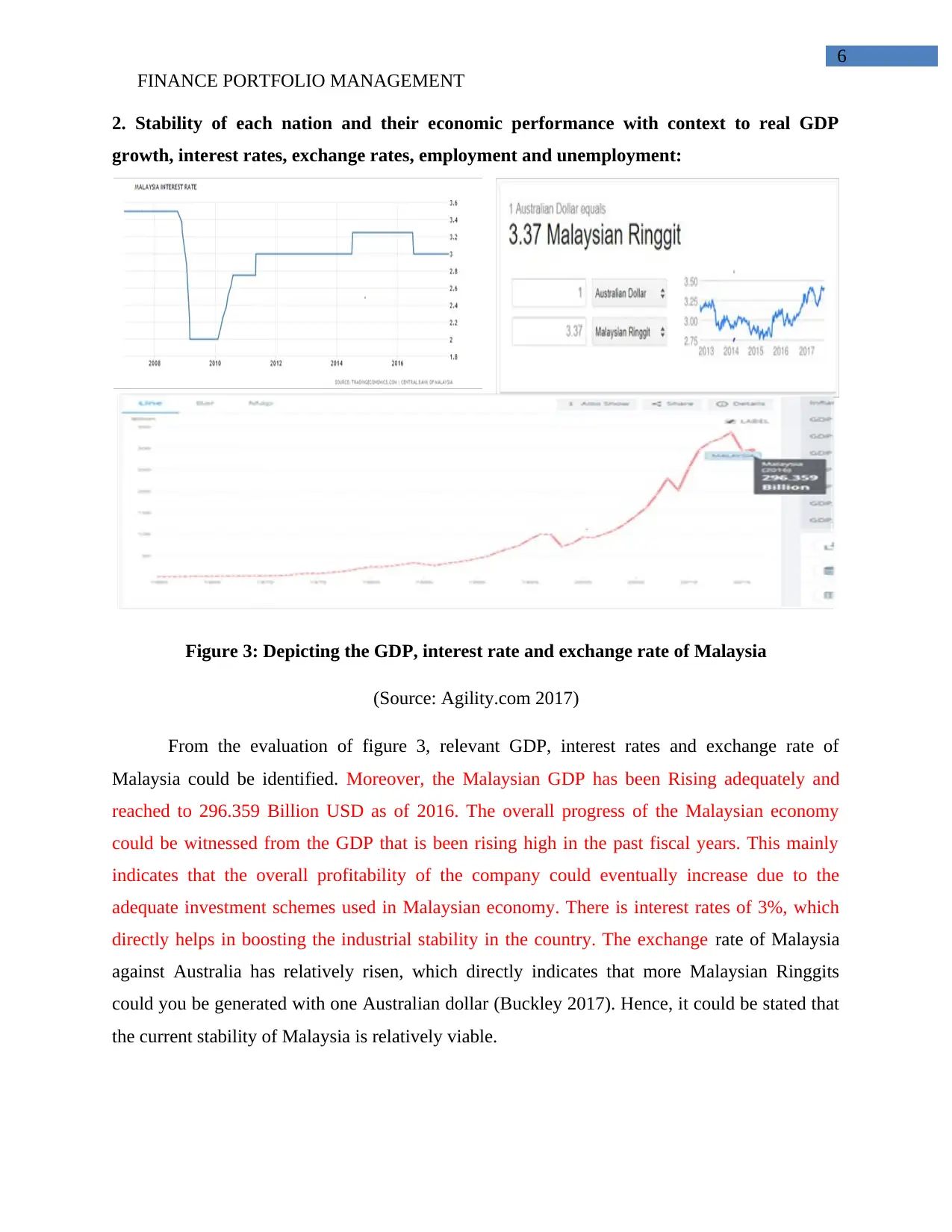
FINANCE PORTFOLIO MANAGEMENT
6
2. Stability of each nation and their economic performance with context to real GDP
growth, interest rates, exchange rates, employment and unemployment:
Figure 3: Depicting the GDP, interest rate and exchange rate of Malaysia
(Source: Agility.com 2017)
From the evaluation of figure 3, relevant GDP, interest rates and exchange rate of
Malaysia could be identified. Moreover, the Malaysian GDP has been Rising adequately and
reached to 296.359 Billion USD as of 2016. The overall progress of the Malaysian economy
could be witnessed from the GDP that is been rising high in the past fiscal years. This mainly
indicates that the overall profitability of the company could eventually increase due to the
adequate investment schemes used in Malaysian economy. There is interest rates of 3%, which
directly helps in boosting the industrial stability in the country. The exchange rate of Malaysia
against Australia has relatively risen, which directly indicates that more Malaysian Ringgits
could you be generated with one Australian dollar (Buckley 2017). Hence, it could be stated that
the current stability of Malaysia is relatively viable.
6
2. Stability of each nation and their economic performance with context to real GDP
growth, interest rates, exchange rates, employment and unemployment:
Figure 3: Depicting the GDP, interest rate and exchange rate of Malaysia
(Source: Agility.com 2017)
From the evaluation of figure 3, relevant GDP, interest rates and exchange rate of
Malaysia could be identified. Moreover, the Malaysian GDP has been Rising adequately and
reached to 296.359 Billion USD as of 2016. The overall progress of the Malaysian economy
could be witnessed from the GDP that is been rising high in the past fiscal years. This mainly
indicates that the overall profitability of the company could eventually increase due to the
adequate investment schemes used in Malaysian economy. There is interest rates of 3%, which
directly helps in boosting the industrial stability in the country. The exchange rate of Malaysia
against Australia has relatively risen, which directly indicates that more Malaysian Ringgits
could you be generated with one Australian dollar (Buckley 2017). Hence, it could be stated that
the current stability of Malaysia is relatively viable.
Paraphrase This Document
Need a fresh take? Get an instant paraphrase of this document with our AI Paraphraser
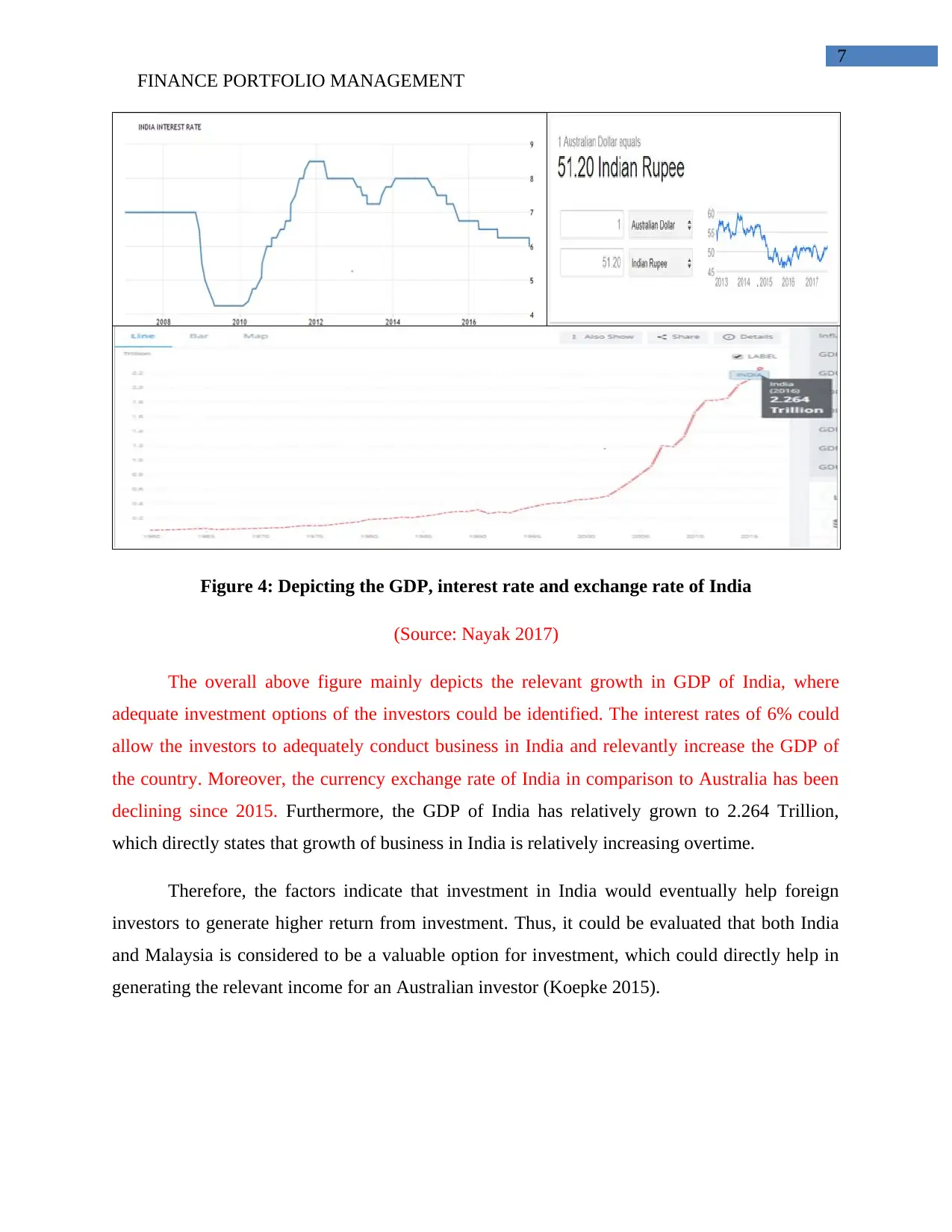
FINANCE PORTFOLIO MANAGEMENT
7
Figure 4: Depicting the GDP, interest rate and exchange rate of India
(Source: Nayak 2017)
The overall above figure mainly depicts the relevant growth in GDP of India, where
adequate investment options of the investors could be identified. The interest rates of 6% could
allow the investors to adequately conduct business in India and relevantly increase the GDP of
the country. Moreover, the currency exchange rate of India in comparison to Australia has been
declining since 2015. Furthermore, the GDP of India has relatively grown to 2.264 Trillion,
which directly states that growth of business in India is relatively increasing overtime.
Therefore, the factors indicate that investment in India would eventually help foreign
investors to generate higher return from investment. Thus, it could be evaluated that both India
and Malaysia is considered to be a valuable option for investment, which could directly help in
generating the relevant income for an Australian investor (Koepke 2015).
7
Figure 4: Depicting the GDP, interest rate and exchange rate of India
(Source: Nayak 2017)
The overall above figure mainly depicts the relevant growth in GDP of India, where
adequate investment options of the investors could be identified. The interest rates of 6% could
allow the investors to adequately conduct business in India and relevantly increase the GDP of
the country. Moreover, the currency exchange rate of India in comparison to Australia has been
declining since 2015. Furthermore, the GDP of India has relatively grown to 2.264 Trillion,
which directly states that growth of business in India is relatively increasing overtime.
Therefore, the factors indicate that investment in India would eventually help foreign
investors to generate higher return from investment. Thus, it could be evaluated that both India
and Malaysia is considered to be a valuable option for investment, which could directly help in
generating the relevant income for an Australian investor (Koepke 2015).
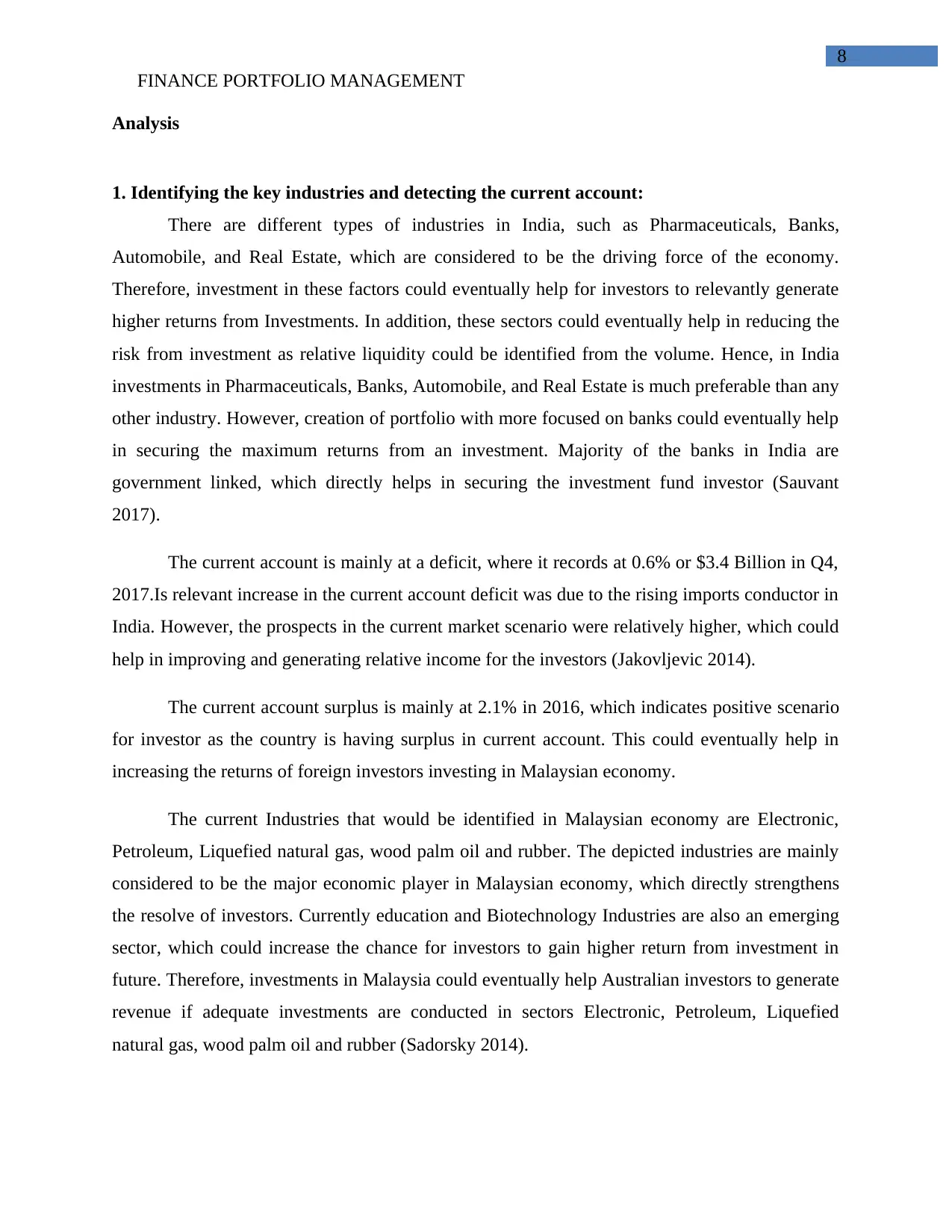
FINANCE PORTFOLIO MANAGEMENT
8
Analysis
1. Identifying the key industries and detecting the current account:
There are different types of industries in India, such as Pharmaceuticals, Banks,
Automobile, and Real Estate, which are considered to be the driving force of the economy.
Therefore, investment in these factors could eventually help for investors to relevantly generate
higher returns from Investments. In addition, these sectors could eventually help in reducing the
risk from investment as relative liquidity could be identified from the volume. Hence, in India
investments in Pharmaceuticals, Banks, Automobile, and Real Estate is much preferable than any
other industry. However, creation of portfolio with more focused on banks could eventually help
in securing the maximum returns from an investment. Majority of the banks in India are
government linked, which directly helps in securing the investment fund investor (Sauvant
2017).
The current account is mainly at a deficit, where it records at 0.6% or $3.4 Billion in Q4,
2017.Is relevant increase in the current account deficit was due to the rising imports conductor in
India. However, the prospects in the current market scenario were relatively higher, which could
help in improving and generating relative income for the investors (Jakovljevic 2014).
The current account surplus is mainly at 2.1% in 2016, which indicates positive scenario
for investor as the country is having surplus in current account. This could eventually help in
increasing the returns of foreign investors investing in Malaysian economy.
The current Industries that would be identified in Malaysian economy are Electronic,
Petroleum, Liquefied natural gas, wood palm oil and rubber. The depicted industries are mainly
considered to be the major economic player in Malaysian economy, which directly strengthens
the resolve of investors. Currently education and Biotechnology Industries are also an emerging
sector, which could increase the chance for investors to gain higher return from investment in
future. Therefore, investments in Malaysia could eventually help Australian investors to generate
revenue if adequate investments are conducted in sectors Electronic, Petroleum, Liquefied
natural gas, wood palm oil and rubber (Sadorsky 2014).
8
Analysis
1. Identifying the key industries and detecting the current account:
There are different types of industries in India, such as Pharmaceuticals, Banks,
Automobile, and Real Estate, which are considered to be the driving force of the economy.
Therefore, investment in these factors could eventually help for investors to relevantly generate
higher returns from Investments. In addition, these sectors could eventually help in reducing the
risk from investment as relative liquidity could be identified from the volume. Hence, in India
investments in Pharmaceuticals, Banks, Automobile, and Real Estate is much preferable than any
other industry. However, creation of portfolio with more focused on banks could eventually help
in securing the maximum returns from an investment. Majority of the banks in India are
government linked, which directly helps in securing the investment fund investor (Sauvant
2017).
The current account is mainly at a deficit, where it records at 0.6% or $3.4 Billion in Q4,
2017.Is relevant increase in the current account deficit was due to the rising imports conductor in
India. However, the prospects in the current market scenario were relatively higher, which could
help in improving and generating relative income for the investors (Jakovljevic 2014).
The current account surplus is mainly at 2.1% in 2016, which indicates positive scenario
for investor as the country is having surplus in current account. This could eventually help in
increasing the returns of foreign investors investing in Malaysian economy.
The current Industries that would be identified in Malaysian economy are Electronic,
Petroleum, Liquefied natural gas, wood palm oil and rubber. The depicted industries are mainly
considered to be the major economic player in Malaysian economy, which directly strengthens
the resolve of investors. Currently education and Biotechnology Industries are also an emerging
sector, which could increase the chance for investors to gain higher return from investment in
future. Therefore, investments in Malaysia could eventually help Australian investors to generate
revenue if adequate investments are conducted in sectors Electronic, Petroleum, Liquefied
natural gas, wood palm oil and rubber (Sadorsky 2014).
⊘ This is a preview!⊘
Do you want full access?
Subscribe today to unlock all pages.

Trusted by 1+ million students worldwide

FINANCE PORTFOLIO MANAGEMENT
9
2. Evaluating the recent performance of cash, fixed interest, and equities:
Malaysian Value
Particulars Value
Fixed interest rate 3.10%
Equities
Table 1: Depicting the market index and fixed interest rate of Malaysia
(Source: Malaysiastock.biz 2017)
Table 1 mainly helps in identifying the fixed interest rate of 3.10% in Malaysia, which
could help in investors and higher returns from riskless investment. The Malaysian index could
also be identified from the above table, which directly indicates the progress that is made by the
Malaysian stock market (Anzbusiness.com 2017). Nevertheless, the evaluation of the current
analysis mainly states that the trend in the Malaysian market is upward, which would help
investors in Getting higher returns from Investments. The evaluation of the overall market trend
would eventually help investors detect any investment opportunity, which will in turn help in
generating higher returns from investment. The investment in liquefied natural gas, electronic,
rubber and Biotechnology industries in Malaysia could eventually help in generating high returns
9
2. Evaluating the recent performance of cash, fixed interest, and equities:
Malaysian Value
Particulars Value
Fixed interest rate 3.10%
Equities
Table 1: Depicting the market index and fixed interest rate of Malaysia
(Source: Malaysiastock.biz 2017)
Table 1 mainly helps in identifying the fixed interest rate of 3.10% in Malaysia, which
could help in investors and higher returns from riskless investment. The Malaysian index could
also be identified from the above table, which directly indicates the progress that is made by the
Malaysian stock market (Anzbusiness.com 2017). Nevertheless, the evaluation of the current
analysis mainly states that the trend in the Malaysian market is upward, which would help
investors in Getting higher returns from Investments. The evaluation of the overall market trend
would eventually help investors detect any investment opportunity, which will in turn help in
generating higher returns from investment. The investment in liquefied natural gas, electronic,
rubber and Biotechnology industries in Malaysia could eventually help in generating high returns
Paraphrase This Document
Need a fresh take? Get an instant paraphrase of this document with our AI Paraphraser
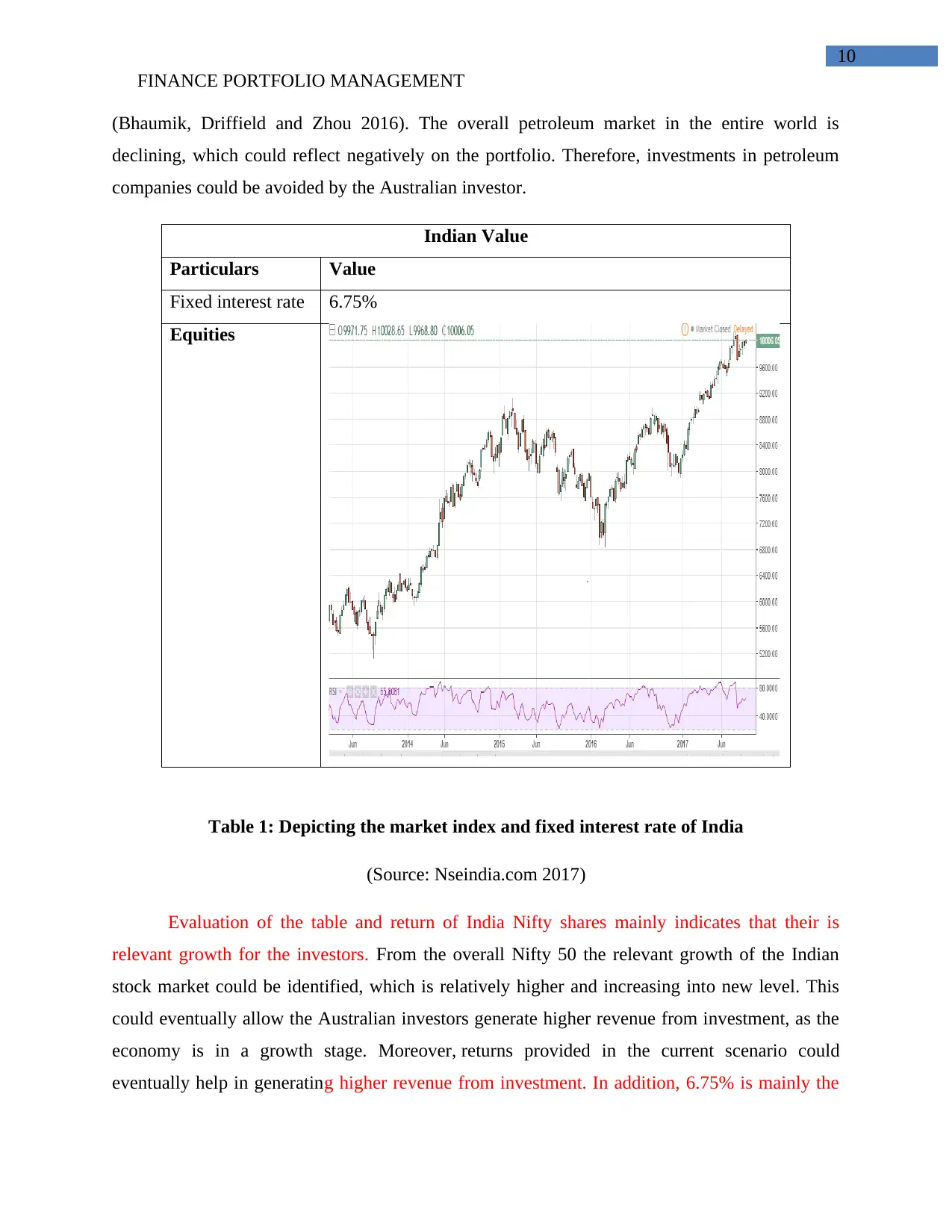
FINANCE PORTFOLIO MANAGEMENT
10
(Bhaumik, Driffield and Zhou 2016). The overall petroleum market in the entire world is
declining, which could reflect negatively on the portfolio. Therefore, investments in petroleum
companies could be avoided by the Australian investor.
Indian Value
Particulars Value
Fixed interest rate 6.75%
Equities
Table 1: Depicting the market index and fixed interest rate of India
(Source: Nseindia.com 2017)
Evaluation of the table and return of India Nifty shares mainly indicates that their is
relevant growth for the investors. From the overall Nifty 50 the relevant growth of the Indian
stock market could be identified, which is relatively higher and increasing into new level. This
could eventually allow the Australian investors generate higher revenue from investment, as the
economy is in a growth stage. Moreover, returns provided in the current scenario could
eventually help in generating higher revenue from investment. In addition, 6.75% is mainly the
10
(Bhaumik, Driffield and Zhou 2016). The overall petroleum market in the entire world is
declining, which could reflect negatively on the portfolio. Therefore, investments in petroleum
companies could be avoided by the Australian investor.
Indian Value
Particulars Value
Fixed interest rate 6.75%
Equities
Table 1: Depicting the market index and fixed interest rate of India
(Source: Nseindia.com 2017)
Evaluation of the table and return of India Nifty shares mainly indicates that their is
relevant growth for the investors. From the overall Nifty 50 the relevant growth of the Indian
stock market could be identified, which is relatively higher and increasing into new level. This
could eventually allow the Australian investors generate higher revenue from investment, as the
economy is in a growth stage. Moreover, returns provided in the current scenario could
eventually help in generating higher revenue from investment. In addition, 6.75% is mainly the
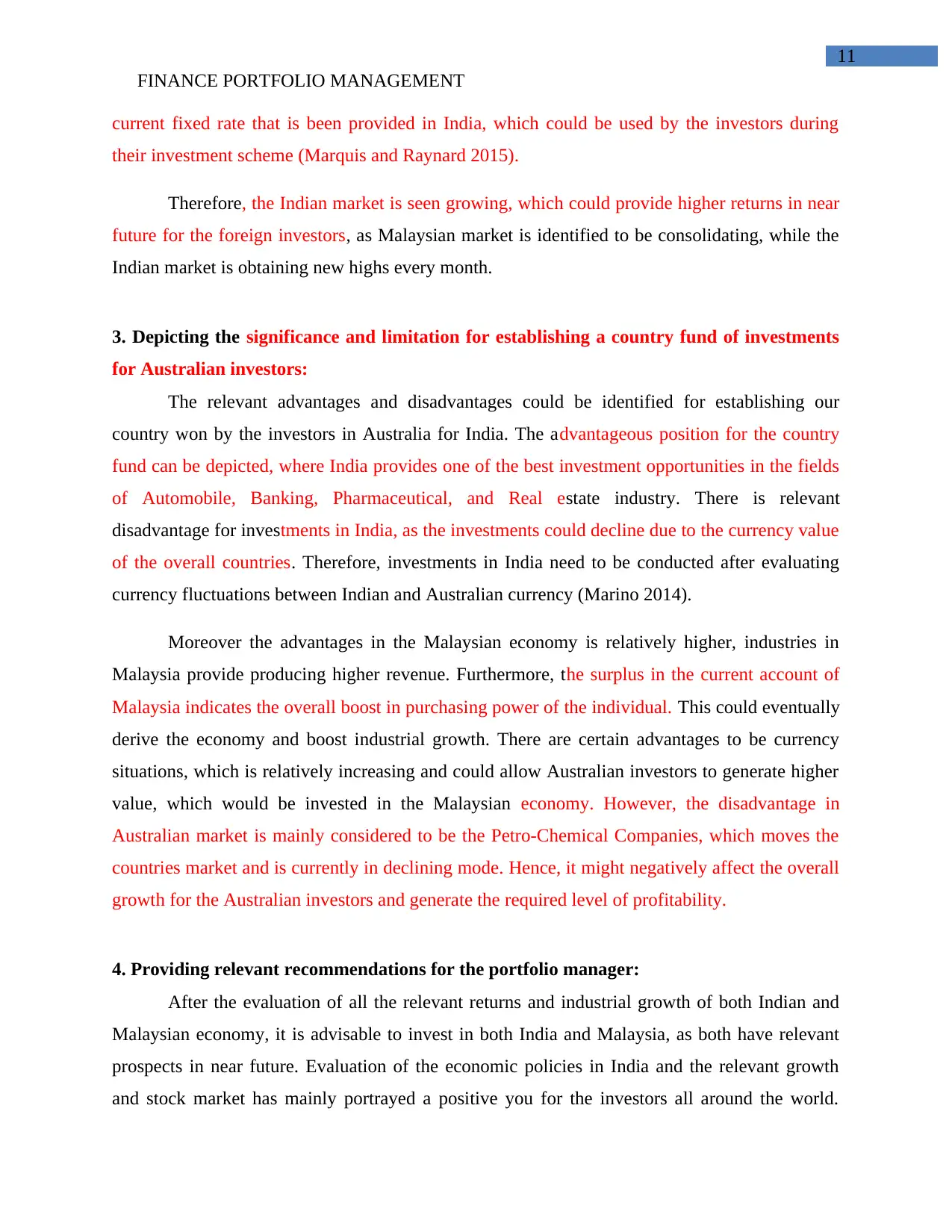
FINANCE PORTFOLIO MANAGEMENT
11
current fixed rate that is been provided in India, which could be used by the investors during
their investment scheme (Marquis and Raynard 2015).
Therefore, the Indian market is seen growing, which could provide higher returns in near
future for the foreign investors, as Malaysian market is identified to be consolidating, while the
Indian market is obtaining new highs every month.
3. Depicting the significance and limitation for establishing a country fund of investments
for Australian investors:
The relevant advantages and disadvantages could be identified for establishing our
country won by the investors in Australia for India. The advantageous position for the country
fund can be depicted, where India provides one of the best investment opportunities in the fields
of Automobile, Banking, Pharmaceutical, and Real estate industry. There is relevant
disadvantage for investments in India, as the investments could decline due to the currency value
of the overall countries. Therefore, investments in India need to be conducted after evaluating
currency fluctuations between Indian and Australian currency (Marino 2014).
Moreover the advantages in the Malaysian economy is relatively higher, industries in
Malaysia provide producing higher revenue. Furthermore, the surplus in the current account of
Malaysia indicates the overall boost in purchasing power of the individual. This could eventually
derive the economy and boost industrial growth. There are certain advantages to be currency
situations, which is relatively increasing and could allow Australian investors to generate higher
value, which would be invested in the Malaysian economy. However, the disadvantage in
Australian market is mainly considered to be the Petro-Chemical Companies, which moves the
countries market and is currently in declining mode. Hence, it might negatively affect the overall
growth for the Australian investors and generate the required level of profitability.
4. Providing relevant recommendations for the portfolio manager:
After the evaluation of all the relevant returns and industrial growth of both Indian and
Malaysian economy, it is advisable to invest in both India and Malaysia, as both have relevant
prospects in near future. Evaluation of the economic policies in India and the relevant growth
and stock market has mainly portrayed a positive you for the investors all around the world.
11
current fixed rate that is been provided in India, which could be used by the investors during
their investment scheme (Marquis and Raynard 2015).
Therefore, the Indian market is seen growing, which could provide higher returns in near
future for the foreign investors, as Malaysian market is identified to be consolidating, while the
Indian market is obtaining new highs every month.
3. Depicting the significance and limitation for establishing a country fund of investments
for Australian investors:
The relevant advantages and disadvantages could be identified for establishing our
country won by the investors in Australia for India. The advantageous position for the country
fund can be depicted, where India provides one of the best investment opportunities in the fields
of Automobile, Banking, Pharmaceutical, and Real estate industry. There is relevant
disadvantage for investments in India, as the investments could decline due to the currency value
of the overall countries. Therefore, investments in India need to be conducted after evaluating
currency fluctuations between Indian and Australian currency (Marino 2014).
Moreover the advantages in the Malaysian economy is relatively higher, industries in
Malaysia provide producing higher revenue. Furthermore, the surplus in the current account of
Malaysia indicates the overall boost in purchasing power of the individual. This could eventually
derive the economy and boost industrial growth. There are certain advantages to be currency
situations, which is relatively increasing and could allow Australian investors to generate higher
value, which would be invested in the Malaysian economy. However, the disadvantage in
Australian market is mainly considered to be the Petro-Chemical Companies, which moves the
countries market and is currently in declining mode. Hence, it might negatively affect the overall
growth for the Australian investors and generate the required level of profitability.
4. Providing relevant recommendations for the portfolio manager:
After the evaluation of all the relevant returns and industrial growth of both Indian and
Malaysian economy, it is advisable to invest in both India and Malaysia, as both have relevant
prospects in near future. Evaluation of the economic policies in India and the relevant growth
and stock market has mainly portrayed a positive you for the investors all around the world.
⊘ This is a preview!⊘
Do you want full access?
Subscribe today to unlock all pages.

Trusted by 1+ million students worldwide
1 out of 15
Related Documents
Your All-in-One AI-Powered Toolkit for Academic Success.
+13062052269
info@desklib.com
Available 24*7 on WhatsApp / Email
![[object Object]](/_next/static/media/star-bottom.7253800d.svg)
Unlock your academic potential
Copyright © 2020–2025 A2Z Services. All Rights Reserved. Developed and managed by ZUCOL.





